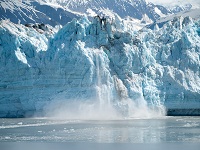 A paper published in the journal Science earlier this month suggests a new formula for estimating the speed of ice sheet flow - with implications for predictions of sea level rise.
A paper published in the journal Science earlier this month suggests a new formula for estimating the speed of ice sheet flow - with implications for predictions of sea level rise.Data from 140 glaciers in Greenland was analysed by researchers at the University of Kansas in order to shed further light on processes at the ice-bed interface.
The researchers examined decade-old studies of water pressure underneath mountain glaciers, pairing these analyses with more recent observations on surface velocity from outlet glaciers in Greenland. The results were published in the journal Science in June.
In their paper, the researchers argue that friction - or 'basal drag' - between ice sheets and the hard bed underneath has no influence on the speed of glacier flow. Instead, they say they discovered a strong relationship between the speed of ice flow and subglacial water pressure between the bottom of the ice sheet and hard bed underneath.
The researchers write: "The largest uncertainty in ice sheet models used to predict future sea-level rise originates from our limited understanding of processes at the ice-bed interface. Near glacier termini, where basal sliding controls ice flow, most predictive ice sheet models use a parameterization of sliding that has been theoretically derived for glacier flow over a hard bed. We find that this sliding relation does not apply to the 140 Greenland glaciers that we analyzed. There is no relationship between basal sliding and frictional stress at the glacier bed, contrary to theoretical predictions. There is a strong relationship between sliding speed and net pressure at the glacier bed. This latter finding is in agreement with earlier observations on mountain glaciers that have been largely overlooked by the glaciological community."
In their paper, the researchers argue that friction - or 'basal drag' - between ice sheets and the hard bed underneath has no influence on the speed of glacier flow. Instead, they say they discovered a strong relationship between the speed of ice flow and subglacial water pressure between the bottom of the ice sheet and hard bed underneath.
The researchers write: "The largest uncertainty in ice sheet models used to predict future sea-level rise originates from our limited understanding of processes at the ice-bed interface. Near glacier termini, where basal sliding controls ice flow, most predictive ice sheet models use a parameterization of sliding that has been theoretically derived for glacier flow over a hard bed. We find that this sliding relation does not apply to the 140 Greenland glaciers that we analyzed. There is no relationship between basal sliding and frictional stress at the glacier bed, contrary to theoretical predictions. There is a strong relationship between sliding speed and net pressure at the glacier bed. This latter finding is in agreement with earlier observations on mountain glaciers that have been largely overlooked by the glaciological community."






